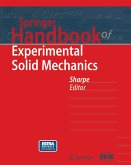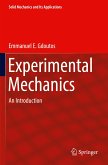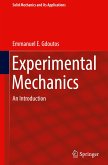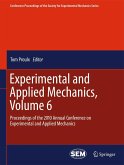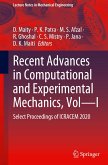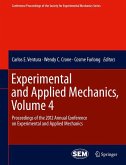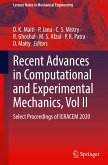Sharpe, Jr., William N. (ed.)
Springer Handbook of Experimental Solid Mechanics, m. 1 Buch, m. 1 E-Book
Herausgegeben:Sharpe, Jr., William N.
Versandkostenfrei innerhalb Deutschlands
468,99 €
inkl. MwSt.
Versandkostenfrei*
Liefertermin unbestimmt
Melden Sie sich
hier
hier
für den Produktalarm an, um über die Verfügbarkeit des Produkts informiert zu werden.

234 °P sammeln
Sharpe, Jr., William N. (ed.)
Springer Handbook of Experimental Solid Mechanics, m. 1 Buch, m. 1 E-Book
Herausgegeben:Sharpe, Jr., William N.
- Audio CD mit DVD
As a reference book, the Springer Handbook provides a comprehensive exposition of the techniques and tools of experimental mechanics. An informative introduction to each topic is provided, which advises the reader on suitable techniques for practical applications. New topics include biological materials, MEMS and NEMS, nanoindentation, digital photomechanics, photoacoustic characterization, and atomic force microscopy in experimental solid mechanics. Written and compiled by internationally renowned experts in the field, this book is a timely, updated reference for both practitioners and researchers in science and engineering. …mehr
Andere Kunden interessierten sich auch für
![Springer Handbook of Experimental Solid Mechanics Springer Handbook of Experimental Solid Mechanics]() Sharpe, Jr., William N. (ed.)Springer Handbook of Experimental Solid Mechanics325,99 €
Sharpe, Jr., William N. (ed.)Springer Handbook of Experimental Solid Mechanics325,99 €![Experimental Mechanics Experimental Mechanics]() Emmanuel E. GdoutosExperimental Mechanics61,99 €
Emmanuel E. GdoutosExperimental Mechanics61,99 €![Experimental Mechanics Experimental Mechanics]() Emmanuel E. GdoutosExperimental Mechanics83,99 €
Emmanuel E. GdoutosExperimental Mechanics83,99 €![Experimental and Applied Mechanics, Volume 6 Experimental and Applied Mechanics, Volume 6]() Experimental and Applied Mechanics, Volume 6226,99 €
Experimental and Applied Mechanics, Volume 6226,99 €![Recent Advances in Computational and Experimental Mechanics, Vol-I Recent Advances in Computational and Experimental Mechanics, Vol-I]() Recent Advances in Computational and Experimental Mechanics, Vol-I226,99 €
Recent Advances in Computational and Experimental Mechanics, Vol-I226,99 €![Experimental and Applied Mechanics, Volume 4 Experimental and Applied Mechanics, Volume 4]() Experimental and Applied Mechanics, Volume 4152,99 €
Experimental and Applied Mechanics, Volume 4152,99 €![Recent Advances in Computational and Experimental Mechanics, Vol II Recent Advances in Computational and Experimental Mechanics, Vol II]() Recent Advances in Computational and Experimental Mechanics, Vol II226,99 €
Recent Advances in Computational and Experimental Mechanics, Vol II226,99 €-
-
-
As a reference book, the Springer Handbook provides a comprehensive exposition of the techniques and tools of experimental mechanics. An informative introduction to each topic is provided, which advises the reader on suitable techniques for practical applications. New topics include biological materials, MEMS and NEMS, nanoindentation, digital photomechanics, photoacoustic characterization, and atomic force microscopy in experimental solid mechanics. Written and compiled by internationally renowned experts in the field, this book is a timely, updated reference for both practitioners and researchers in science and engineering.
Produktdetails
- Produktdetails
- Springer Handbooks
- Verlag: Springer / Springer US / Springer, Berlin
- Artikelnr. des Verlages: 978-0-387-34362-4
- Seitenzahl: 1098
- Englisch
- Abmessung: 254mm
- ISBN-13: 9780387343624
- ISBN-10: 0387343628
- Artikelnr.: 23463600
- Herstellerkennzeichnung Die Herstellerinformationen sind derzeit nicht verfügbar.
- Springer Handbooks
- Verlag: Springer / Springer US / Springer, Berlin
- Artikelnr. des Verlages: 978-0-387-34362-4
- Seitenzahl: 1098
- Englisch
- Abmessung: 254mm
- ISBN-13: 9780387343624
- ISBN-10: 0387343628
- Artikelnr.: 23463600
- Herstellerkennzeichnung Die Herstellerinformationen sind derzeit nicht verfügbar.
Part A Solid Mechanics Topics
Part A presents topics that fall within the purview of solid mechanics. The first five chapters cover familiar ground, but the next four present new material systems along with the new topics of MEMS and NEMS. The last two chapters describe methods of interpreting the results of tests.
Chap. 1 Analytical Mechanics of Solids
Chap. 2 Materials Science for the Experimental Mechanist
Chap. 3 Polymers and Viscoelasticity
Chap. 4 Composite Materials
Chap. 5 Fracture Mechanics
Chap. 6 Active Materials
Chap. 7 Biological Soft Tissues
Chap. 8 Ionic Polymer-Metal Composites
Chap. 9 MEMS and NEMS
Chap. 10 Hybrid Methods
Chap. 11 Statistical Analysis of Experimental Data
Part B Contact Methods
Part B starts with three practical chapters on the 'backbones' of experimental solid mechanics - strain gages and extensometers - followed by another mainstay - residual stress measurement. Nanoindentation is becoming more widely used for material property determination as is atomic force microscopy.
Chap. 12 Electrical Resistance Strain Gages
Chap. 13 Extensometers
Chap. 14 Fiber Strain Gages
Chap. 15 Residual Stress Measurement
Chap. 16 Nanoindentation
Chap. 17 Atomic Force Microscopy
Part C Noncontact Methods
Part C is an overview of the rich field of optical methods in the first eight chapters ranging from modern versions of established such as photoelasticity to newer ones based on image analysis. Non-contacting methods at other wavelengths are described in the last three chapters.
Chap. 18 Basics of Optics
Chap. 19 Image Analysis and Processing
Chap. 20 Digital Image Correlation
Chap. 21 Geometric Moiré
Chap. 22 Moiré Interferometry
Chap. 23 Speckle Methods
Chap. 24 Holography
Chap. 25 Photoelasticity
Chap. 26 Thermoelastic Stress Analysis
Chap. 27 Photoacoustic Characterization of Materials
Chap. 28 X-Ray Stress Analysis
Part D Applications
Part D presents applications of the methods and topics of the three previous parts to selected topics - all of which are new and important areas of modern technology. These are examples that demonstrate the breadth and depth of experimental solid mechanics.
Chap. 29 Optical Methods
Chap. 30 Mechanical Testing at the Micro/Nano Scale
Chap. 31 Biological Tissue Testing
Chap. 32 Biomedical Devices and Biologically Inspired Materials
Chap. 33 High Strain Rate and Impact Testing
Chap. 34 Delamination Mechanics
Chap. 35 Structural Testing Applications
Chap. 36 Electronic Packaging
About the Authors.- Subject Index
Part A presents topics that fall within the purview of solid mechanics. The first five chapters cover familiar ground, but the next four present new material systems along with the new topics of MEMS and NEMS. The last two chapters describe methods of interpreting the results of tests.
Chap. 1 Analytical Mechanics of Solids
Chap. 2 Materials Science for the Experimental Mechanist
Chap. 3 Polymers and Viscoelasticity
Chap. 4 Composite Materials
Chap. 5 Fracture Mechanics
Chap. 6 Active Materials
Chap. 7 Biological Soft Tissues
Chap. 8 Ionic Polymer-Metal Composites
Chap. 9 MEMS and NEMS
Chap. 10 Hybrid Methods
Chap. 11 Statistical Analysis of Experimental Data
Part B Contact Methods
Part B starts with three practical chapters on the 'backbones' of experimental solid mechanics - strain gages and extensometers - followed by another mainstay - residual stress measurement. Nanoindentation is becoming more widely used for material property determination as is atomic force microscopy.
Chap. 12 Electrical Resistance Strain Gages
Chap. 13 Extensometers
Chap. 14 Fiber Strain Gages
Chap. 15 Residual Stress Measurement
Chap. 16 Nanoindentation
Chap. 17 Atomic Force Microscopy
Part C Noncontact Methods
Part C is an overview of the rich field of optical methods in the first eight chapters ranging from modern versions of established such as photoelasticity to newer ones based on image analysis. Non-contacting methods at other wavelengths are described in the last three chapters.
Chap. 18 Basics of Optics
Chap. 19 Image Analysis and Processing
Chap. 20 Digital Image Correlation
Chap. 21 Geometric Moiré
Chap. 22 Moiré Interferometry
Chap. 23 Speckle Methods
Chap. 24 Holography
Chap. 25 Photoelasticity
Chap. 26 Thermoelastic Stress Analysis
Chap. 27 Photoacoustic Characterization of Materials
Chap. 28 X-Ray Stress Analysis
Part D Applications
Part D presents applications of the methods and topics of the three previous parts to selected topics - all of which are new and important areas of modern technology. These are examples that demonstrate the breadth and depth of experimental solid mechanics.
Chap. 29 Optical Methods
Chap. 30 Mechanical Testing at the Micro/Nano Scale
Chap. 31 Biological Tissue Testing
Chap. 32 Biomedical Devices and Biologically Inspired Materials
Chap. 33 High Strain Rate and Impact Testing
Chap. 34 Delamination Mechanics
Chap. 35 Structural Testing Applications
Chap. 36 Electronic Packaging
About the Authors.- Subject Index
Part A Solid Mechanics Topics
Part A presents topics that fall within the purview of solid mechanics. The first five chapters cover familiar ground, but the next four present new material systems along with the new topics of MEMS and NEMS. The last two chapters describe methods of interpreting the results of tests.
Chap. 1 Analytical Mechanics of Solids
Chap. 2 Materials Science for the Experimental Mechanist
Chap. 3 Polymers and Viscoelasticity
Chap. 4 Composite Materials
Chap. 5 Fracture Mechanics
Chap. 6 Active Materials
Chap. 7 Biological Soft Tissues
Chap. 8 Ionic Polymer-Metal Composites
Chap. 9 MEMS and NEMS
Chap. 10 Hybrid Methods
Chap. 11 Statistical Analysis of Experimental Data
Part B Contact Methods
Part B starts with three practical chapters on the 'backbones' of experimental solid mechanics - strain gages and extensometers - followed by another mainstay - residual stress measurement. Nanoindentation is becoming more widely used for material property determination as is atomic force microscopy.
Chap. 12 Electrical Resistance Strain Gages
Chap. 13 Extensometers
Chap. 14 Fiber Strain Gages
Chap. 15 Residual Stress Measurement
Chap. 16 Nanoindentation
Chap. 17 Atomic Force Microscopy
Part C Noncontact Methods
Part C is an overview of the rich field of optical methods in the first eight chapters ranging from modern versions of established such as photoelasticity to newer ones based on image analysis. Non-contacting methods at other wavelengths are described in the last three chapters.
Chap. 18 Basics of Optics
Chap. 19 Image Analysis and Processing
Chap. 20 Digital Image Correlation
Chap. 21 Geometric Moiré
Chap. 22 Moiré Interferometry
Chap. 23 Speckle Methods
Chap. 24 Holography
Chap. 25 Photoelasticity
Chap. 26 Thermoelastic Stress Analysis
Chap. 27 Photoacoustic Characterization of Materials
Chap. 28 X-Ray Stress Analysis
Part D Applications
Part D presents applications of the methods and topics of the three previous parts to selected topics - all of which are new and important areas of modern technology. These are examples that demonstrate the breadth and depth of experimental solid mechanics.
Chap. 29 Optical Methods
Chap. 30 Mechanical Testing at the Micro/Nano Scale
Chap. 31 Biological Tissue Testing
Chap. 32 Biomedical Devices and Biologically Inspired Materials
Chap. 33 High Strain Rate and Impact Testing
Chap. 34 Delamination Mechanics
Chap. 35 Structural Testing Applications
Chap. 36 Electronic Packaging
About the Authors.- Subject Index
Part A presents topics that fall within the purview of solid mechanics. The first five chapters cover familiar ground, but the next four present new material systems along with the new topics of MEMS and NEMS. The last two chapters describe methods of interpreting the results of tests.
Chap. 1 Analytical Mechanics of Solids
Chap. 2 Materials Science for the Experimental Mechanist
Chap. 3 Polymers and Viscoelasticity
Chap. 4 Composite Materials
Chap. 5 Fracture Mechanics
Chap. 6 Active Materials
Chap. 7 Biological Soft Tissues
Chap. 8 Ionic Polymer-Metal Composites
Chap. 9 MEMS and NEMS
Chap. 10 Hybrid Methods
Chap. 11 Statistical Analysis of Experimental Data
Part B Contact Methods
Part B starts with three practical chapters on the 'backbones' of experimental solid mechanics - strain gages and extensometers - followed by another mainstay - residual stress measurement. Nanoindentation is becoming more widely used for material property determination as is atomic force microscopy.
Chap. 12 Electrical Resistance Strain Gages
Chap. 13 Extensometers
Chap. 14 Fiber Strain Gages
Chap. 15 Residual Stress Measurement
Chap. 16 Nanoindentation
Chap. 17 Atomic Force Microscopy
Part C Noncontact Methods
Part C is an overview of the rich field of optical methods in the first eight chapters ranging from modern versions of established such as photoelasticity to newer ones based on image analysis. Non-contacting methods at other wavelengths are described in the last three chapters.
Chap. 18 Basics of Optics
Chap. 19 Image Analysis and Processing
Chap. 20 Digital Image Correlation
Chap. 21 Geometric Moiré
Chap. 22 Moiré Interferometry
Chap. 23 Speckle Methods
Chap. 24 Holography
Chap. 25 Photoelasticity
Chap. 26 Thermoelastic Stress Analysis
Chap. 27 Photoacoustic Characterization of Materials
Chap. 28 X-Ray Stress Analysis
Part D Applications
Part D presents applications of the methods and topics of the three previous parts to selected topics - all of which are new and important areas of modern technology. These are examples that demonstrate the breadth and depth of experimental solid mechanics.
Chap. 29 Optical Methods
Chap. 30 Mechanical Testing at the Micro/Nano Scale
Chap. 31 Biological Tissue Testing
Chap. 32 Biomedical Devices and Biologically Inspired Materials
Chap. 33 High Strain Rate and Impact Testing
Chap. 34 Delamination Mechanics
Chap. 35 Structural Testing Applications
Chap. 36 Electronic Packaging
About the Authors.- Subject Index

